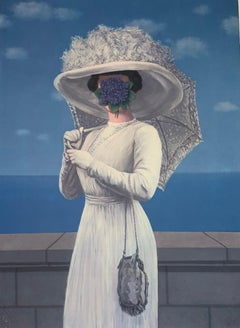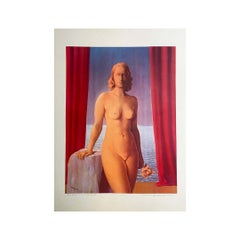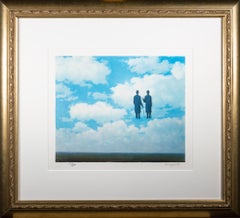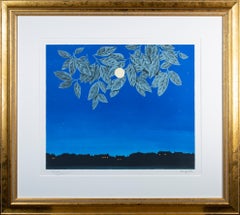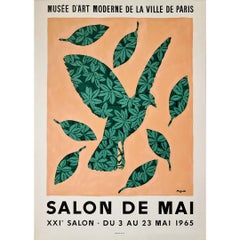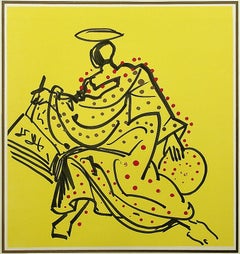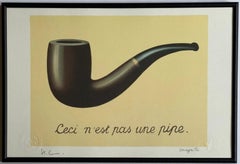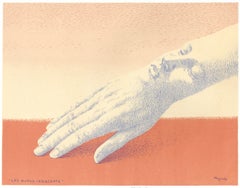René Magritte Art
René Magritte is celebrated today as one of Surrealism’s most talented artists, and, alongside Salvador Dalí, the cheeky, subversive Belgian painter and author is the movement’s best-known representative, having cemented his legacy with what may be the most iconic five words in all of art history: “Ceci n’est pas une pipe” (This is not a pipe).
Magritte’s success, though, hardly came overnight. Born in 1898 in Lessines to a wealthy manufacturer, he studied at the Académie Royale des Beaux-Arts in Brussels from 1916 to 1918 but quit before graduation. His early artistic work wavered between Cubism and semi-abstraction, and he found work as a graphic designer while experimenting with his own creative oeuvre. In the mid-1920s, he began to experiment with Surrealism, then a relatively nascent movement that had grown out of the absurdist Dada. Led by André Breton, Surrealism endeavored to record elements of the subconscious and present contradictory, sometimes even nonsensical, narratives that challenged the notion of an absolute reality.
Magritte’s first widely recognized work within this genre was 1927’s The Menaced Assassin, now in the collection of the Museum of Modern Art in New York. Shortly after completing this work, Magritte relocated to Paris, to be closer to Breton and the center of the Surrealist movement. This decision would prove critical in his life — and in the trajectory of Surrealist art history. The three years Magritte spent in Paris were his most prolific, and by the close of the 1920s he had completed some of his best-known work, including the seminal 1929 The Treachery of Images, a simple picture of what appears to be a pipe, with the words “Ceci n’est pas une pipe” in neat script below it.
Magritte returned to Brussels in the early 1930s but continued experimenting with work that wavered between dreamlike and nonsensical. His influences throughout this part of his career ranged from Breton to Giorgio de Chirico and Dalí. While living in German-occupied Belgium beginning in the early 1940s, Magritte entered what is often called his Renoir period or what he labeled “Sunlit Surrealism.” He worked in comparatively brighter, more vibrant colors and produced oil paintings and gouaches that were overrun with light and the type of brushstrokes that are usually associated with Impressionist art.
Like many artists during and after the war, Magritte thought deeply about art’s role in answering big existential questions and broke with Surrealism as a result. His Impressionistic The Fifth Season in 1943 resembled little of what he’d painted in years past. His so-called Vache period that followed would represent another stylistic shift that owed to German Expressionism. Not everything changed, however; Magritte would go on to revisit his earliest creative impulses, in some cases appropriating elements from fellow artists in his own depictions, as with his Perspective II: Manet’s Balcony in 1950, a playful and probing reinterpretation of Edouard Manet’s The Balcony. Later in his career, the artist dabbled in sculpture, before dying in 1967.
Find original René Magritte prints and other art on 1stDibs.
20th Century Surrealist René Magritte Art
Lithograph
1960s René Magritte Art
Lithograph, Paper
1970s Surrealist René Magritte Art
Lithograph
2010s Surrealist René Magritte Art
Lithograph
2010s Surrealist René Magritte Art
Lithograph
1960s Surrealist René Magritte Art
Paper, Lithograph
1960s Surrealist René Magritte Art
Lithograph
2010s Surrealist René Magritte Art
Wood, Mixed Media, Screen
1970s René Magritte Art
Lithograph
Early 2000s Surrealist René Magritte Art
Lithograph
Early 2000s Surrealist René Magritte Art
Lithograph
1940s Surrealist René Magritte Art
Paper, Photogravure
1970s Modern René Magritte Art
Lithograph
1940s Surrealist René Magritte Art
Paper, Photogravure
2010s Surrealist René Magritte Art
Lithograph
1980s René Magritte Art
Photographic Paper
Mid-20th Century Surrealist René Magritte Art
Lithograph
2010s Surrealist René Magritte Art
Lithograph
2010s Surrealist René Magritte Art
Lithograph
2010s Surrealist René Magritte Art
Lithograph
Early 2000s Surrealist René Magritte Art
Lithograph
2010s Surrealist René Magritte Art
Lithograph
2010s Surrealist René Magritte Art
Lithograph
2010s Surrealist René Magritte Art
Lithograph
1960s Surrealist René Magritte Art
Lithograph
1960s Surrealist René Magritte Art
Etching
20th Century Surrealist René Magritte Art
Etching, Aquatint
20th Century Surrealist René Magritte Art
Etching, Aquatint
1960s Surrealist René Magritte Art
Lithograph
1970s Surrealist René Magritte Art
Gold Leaf
1990s Surrealist René Magritte Art
Lithograph
20th Century Surrealist René Magritte Art
Paper, Lithograph
1990s Contemporary René Magritte Art
Paper, Lithograph
21st Century and Contemporary Contemporary René Magritte Art
Lithograph, Linen, Paper
1840s Other Art Style René Magritte Art
Paper, Lithograph
20th Century Surrealist René Magritte Art
Paper, Lithograph
1970s Surrealist René Magritte Art
Laid Paper, Pigment, Lithograph
20th Century Surrealist René Magritte Art
Paper, Lithograph
1970s Surrealist René Magritte Art
Gold Leaf
Early 19th Century English School René Magritte Art
Watercolor, Handmade Paper, Lithograph
2010s Surrealist René Magritte Art
Lithograph
1960s Surrealist René Magritte Art
Lithograph
2010s Surrealist René Magritte Art
Lithograph
2010s Surrealist René Magritte Art
Wood, Screen, Mixed Media
1960s Surrealist René Magritte Art
Lithograph
1960s Surrealist René Magritte Art
Paper, Lithograph
1960s Surrealist René Magritte Art
Etching
1960s Surrealist René Magritte Art
Lithograph
1960s Surrealist René Magritte Art
Lithograph
2010s Surrealist René Magritte Art
Lithograph
2010s Surrealist René Magritte Art
Lithograph
2010s Surrealist René Magritte Art
Lithograph
René Magritte art for sale on 1stDibs.
Artists Similar to René Magritte
- 1stDibs ExpertOctober 7, 2024The difference between Dalí and Magritte in terms of the artists’ work comes down to subject matter and style. Salvador Dalí used hyperrealism in painting Surrealist symbols and concepts that subverted accepted notions of reality and often featured in complex, highly detailed landscapes. On the other hand, René Magritte was less concerned with realism and symbolism. Instead, he challenged the notions of reality through mysterious disembodied figures and objects. He was also fond of repeating the same motifs and even painted multiple versions of single works, while Dalí did not. Shop a range of Salvador Dalí and René Magritte art on 1stDibs.
- 1stDibs ExpertFebruary 21, 2024You can see Magritte paintings in many locations. The Magritte Museum in Brussels, Belgium, has the largest collection, with more than 200 paintings and prints on display. Other museums that have Magritte pieces in their collections include the Museum of Modern Art in New York City, New York; the Art Institute of Chicago in Chicago, Illinois; the Museum of Modern Art in San Francisco, California; the National Gallery of Modern and Contemporary Art in Rome, Italy; and the Museum Folkwang in Essen, Germany. On 1stDibs, find a selection of René Magritte art from some of the world's top dealers and galleries.
- 1stDibs ExpertJanuary 10, 2025A famous quote from René Magritte is, "Art evokes the mystery without which the world would not exist." Another is "All that we see hides something else." With his work, Magritte wished to cultivate an approach that avoided the stylistic distractions of most modern painting. While French Surrealists experimented with new techniques, Magritte settled on a deadpan, illustrative approach that clearly articulated the content of his pictures. Some of his most famous works include The Treachery of Images, The Son of Man and The Lovers. On 1stDibs, shop a selection of René Magritte art.
